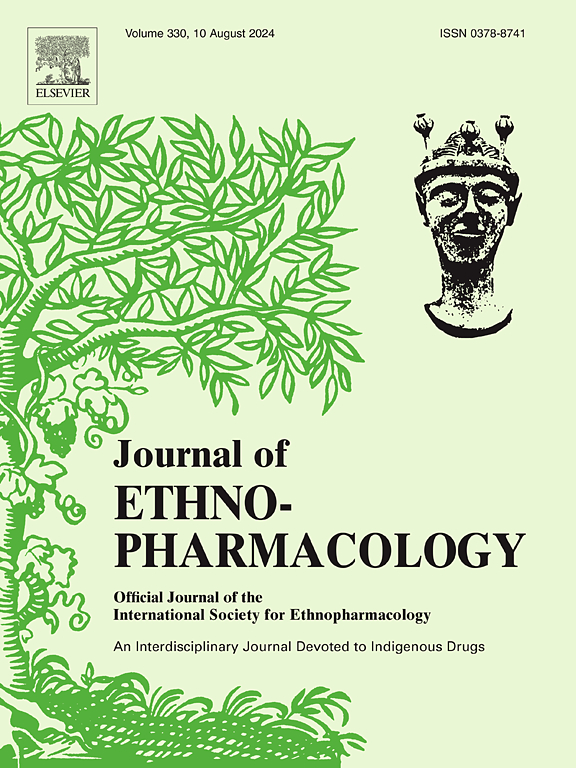Therapeutic effects of self-assembled berberine-glycyrrhizic acid and matrine-glycyrrhizic acid complexes from Qingchang Wenzhong decoction on DSS-induced ulcerative colitis: Mechanisms of anti-inflammatory action
IF 4.8
2区 医学
Q1 CHEMISTRY, MEDICINAL
引用次数: 0
Abstract
Ethnopharmacological relevance
Qingchang Wenzhong Decoction (QCWZD), a traditional Chinese medicine (TCM) formula, has been clinically utilized for ulcerative colitis (UC) treatment due to its anti-inflammatory and intestinal barrier-protective effects. However, the mechanisms by which its naturally self-assembled supramolecular complexes, formed during aqueous decoction, contribute to therapeutic outcomes remain underexplored, representing a critical gap in understanding TCM's holistic pharmacology.
Aim of the study
This study sought to elucidate the self-assembly mechanisms underlying QCWZD's therapeutic effects, with a focus on characterizing the anti-inflammatory properties of its naturally self-assembled complexes formed during decoction and their role in UC intervention.
Methods
The submicron precipitate of QCWZD was isolated via gradient centrifugation and characterized for size and morphology using dynamic light scattering (DLS) and scanning electron microscopy (SEM). A DSS-induced murine UC model was used to evaluate the efficacy of QCWZD and its fractions (supernatant and submicron precipitate). Meanwhile, UPLC-ZenoTOF-MS/MS and triple quadrupole LC-MS/MS were employed to identify and quantify the bioactive components. Representative self-assembled complexes were synthesized under conditions mimicking decoction and characterized using DLS and SEM. Thermodynamic binding behavior was probed using isothermal titration calorimetry (ITC). Non-covalent interaction mechanisms of complex formation were characterized by UV, FT-IR, and 1H NMR spectroscopy. Anti-inflammatory activity of the self-assembled complexes was validated in LPS-stimulated RAW264.7 macrophages.
Results
QCWZD's submicron precipitate accelerated UC remission in mice, reducing the disease activity index (DAI), restoring colon length, and suppressing NF-κB p65 phosphorylation compared to the model group. Mass spectrometry identified berberine-glycyrrhizic acid (BER-GL) and matrine-glycyrrhizic acid (MAT-GL) as dominant self-assembled complexes. ITC revealed binding affinity between glycyrrhizic acid (GL) and alkaloids (BER: Kd = 2.55 × 10−4 M, 1:1 binding ratio; MAT: Kd = 6.77 × 10−4 M, 1:2 binding ratio), driven by enthalpy. Charge-transfer and hydrogen-bonding interactions between glycyrrhizic acid (GL) and the alkaloids berberine (BER) and matrine (MAT) lead to stable self-assemblies. BER-GL and MAT-GL complexes significantly suppressed pro-inflammatory cytokines (TNF-α, IL-1β, IL-6) while upregulating IL-10 in RAW264.7 cells, outperforming free alkaloids.
Conclusion
Building on QCWZD's established efficacy in treating ulcerative colitis (UC) via the NF-κB pathway, this work demonstrates that the aqueous self-assembly of BER-GL and MAT-GL, derived from QCWZD's submicron precipitate fraction, critically enhances anti-inflammatory efficacy. These findings bridge TCM's traditional preparation methods with supramolecular pharmacology, providing a mechanistic framework for the holistic effects of herbal decoctions. The study advances ethnopharmacological research by highlighting natural self-assembly as a key determinant of TCM's therapeutic synergy.

清肠文中汤自组装小檗碱-甘草酸和苦参碱-甘草酸复合物对dss诱导的溃疡性结肠炎的治疗作用:抗炎作用机制
民族药理学相关性:清肠文中汤(QCWZD)是一种中药方剂,因其具有抗炎和肠道屏障保护作用,已被临床用于治疗溃疡性结肠炎(UC)。然而,水煎过程中形成的天然自组装超分子复合物对治疗效果的影响机制仍未得到充分探讨,这是理解中医整体药理学的一个关键空白。研究目的:本研究旨在阐明芪芩汤治疗作用的自组装机制,重点研究其在煎煮过程中形成的自然自组装复合物的抗炎特性及其在UC干预中的作用。方法:采用梯度离心分离提取亚微米沉淀物,采用动态光散射(DLS)和扫描电镜(SEM)对其大小和形貌进行表征。采用dss诱导的小鼠UC模型,评价芪芩合剂及其组分(上清液和亚微米沉淀物)的治疗效果。同时,采用UPLC-ZenoTOF-MS/MS和三重四极柱LC-MS/MS对其生物活性成分进行鉴定和定量。在模拟汤剂的条件下合成了具有代表性的自组装配合物,并用DLS和SEM对其进行了表征。用等温滴定量热法(ITC)研究了其热力学结合行为。通过紫外光谱、红外光谱和核磁共振氢谱对络合物的非共价相互作用机理进行了表征。在lps刺激的RAW264.7巨噬细胞中验证了自组装复合物的抗炎活性。结果:与模型组相比,QCWZD亚微米沉淀物加速小鼠UC缓解,降低疾病活动指数(DAI),恢复结肠长度,抑制NF-κB p65磷酸化。质谱鉴定小檗碱-甘草酸(BER-GL)和苦参碱-甘草酸(MAT-GL)为优势自组装复合物。ITC显示甘草酸(GL)与生物碱的结合亲和力(BER: Kd = 2.55×10-4 M,结合比为1:1;MAT: Kd = 6.77×10-4 M,结合比1:2),由焓驱动。甘草酸(GL)与生物碱小檗碱(BER)和苦参碱(MAT)之间的电荷转移和氢键相互作用导致了稳定的自组装。BER-GL和MAT-GL复合物显著抑制RAW264.7细胞中的促炎因子(TNF-α, IL-1β, IL-6),同时上调IL-10,优于游离生物碱。结论:本研究在证实芪楂汤通过NF-κB途径治疗溃疡性结肠炎(UC)的基础上,证实芪楂汤亚微米沉淀物中BER-GL和MAT-GL的水相自组装可显著增强其抗炎作用。这些发现将传统的中药制备方法与超分子药理学相结合,为中药煎剂的整体作用提供了一个机制框架。该研究通过强调自然自组装是中药治疗协同作用的关键决定因素,推进了民族药理学研究。
本文章由计算机程序翻译,如有差异,请以英文原文为准。
求助全文
约1分钟内获得全文
求助全文
来源期刊

Journal of ethnopharmacology
医学-全科医学与补充医学
CiteScore
10.30
自引率
5.60%
发文量
967
审稿时长
77 days
期刊介绍:
The Journal of Ethnopharmacology is dedicated to the exchange of information and understandings about people''s use of plants, fungi, animals, microorganisms and minerals and their biological and pharmacological effects based on the principles established through international conventions. Early people confronted with illness and disease, discovered a wealth of useful therapeutic agents in the plant and animal kingdoms. The empirical knowledge of these medicinal substances and their toxic potential was passed on by oral tradition and sometimes recorded in herbals and other texts on materia medica. Many valuable drugs of today (e.g., atropine, ephedrine, tubocurarine, digoxin, reserpine) came into use through the study of indigenous remedies. Chemists continue to use plant-derived drugs (e.g., morphine, taxol, physostigmine, quinidine, emetine) as prototypes in their attempts to develop more effective and less toxic medicinals.
 求助内容:
求助内容: 应助结果提醒方式:
应助结果提醒方式:


